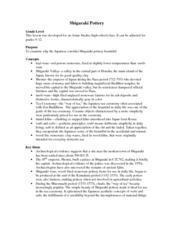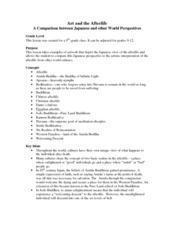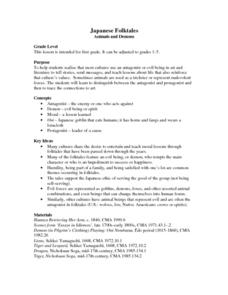Curated OER
Japanese Abstract Wind Sock
Students create Abstract Wind Socks using brown paper bags, markers, kite string, and basic art supplies in this Art lesson for the elementary classroom. Abstract concepts are emphasized and it is recommended to only use primary colors.
Curated OER
Enter Through the Form: Explore Japan Treasure Hunt
Young scholars use the internet to take a virtual treasure hunt to Japan. Using other websites, they gather information on the country's values and beliefs along with its culture and geography. They relate Japan's culture to that of...
Curated OER
Exploring Japan Through Learning Centers
Students explore the Japanese culture and literature through various learning centers. They compare and contrast story details in two stories and complete a Venn diagram. After comparing the stories, they rotate to different centers and...
Curated OER
Tomatoes for Toyotas
Students investigate and become aware of our country's trade relations with East Asia with emphasis placed on Japan. They explore the global affect of technology, production, distribution and consumption as well as exchange and economic...
Curated OER
What Does a Monarch Caterpillar Eat?
Second graders study what monarch caterpillars eat by solving math problems and reading The Girl Who Loved Caterpillars: A Twelfth-Century Tale from Japan. They analyze why Monarch caterpillars only eat milkweed leaves and solve...
Curated OER
Japanese Culture--Comparing the Japanese Educational System to the American
Students study the Japanese educational system and compare and contrast it to the American system. They discuss a typical school day in America and what they believe a typical day is for a Japanese student. Next they write an editorial...
Curated OER
Wartime and the Bill of Rights: The Korematsu Case
Twelfth graders work together in groups to examine the discrimation Japanese Americans felt after the bombing of Pearl Harbor. Using primary source documents, they analyze and discuss the case of Fred Korematsu who was placed in an...
Curated OER
Local Mobilization for War
Tenth graders analyze how government policies led to complete concentration in war effort, evaluate how patriotism was encouraged by many local and state groups, and discuss fate of Japanese Americans.
Curated OER
Japanese Warriors
Learners compare and contrast the warriors in Japanese history, folktales, and art to the kinds of soldiers American children learn about. This lesson includes possible lesson enrichments.
Curated OER
Haniwa
Students use non-fired clay and posterboards to create and display examples of Haniwa and kofun in this exciting lesson for the Social Studies, Humanities, Asian Studies, or Art classroom.
Curated OER
Voyages of Discovery
Young scholars create individual "travel logs" for a world explorer whom they studied in history class. This lesson is an interdisciplinary activity for the Language Arts and History classroom.
Curated OER
Shinto: The Way Of The Gods
Young scholars research and analyze the roots of Shinto in this lesson about Japanese cultural practices and philosophy. Possible lesson enrichments and/or extensions are included with the lesson.
Curated OER
How Japanese Prints Influenced French Artists
Students analyze the influence of Japanese art on French art between 1860 and 1910 in this ideal lesson plan for the high school Social Studies, Humanties, or Asian Studies classroom. Research itechniques are emphasized.
Curated OER
Origami
Students create paper cranes using the art of Origami from Japan as a basis. This lesson includes three lesson enrichment activities, a vocabulary list, and ideas for possible origami materials.
Curated OER
Noh Theater
Students explore the roles in Noh drama and the significance of Noh masks while creating their own version of a Noh play in this High School lesson adaptable for either the Language Arts or Theater classroom.
Curated OER
From Book To The Big Screen
Students create a six-panel byobu (Japanese visual storytelling) based upon the book "To Kill A Mockingbird" in this instructional activity suitable for an early High School Language Arts or Social Studies classroom.
Curated OER
Shigaraki Pottery
Young scholars write position papers from the point of view of a Shigaraki art collector in this instructional activity on pottery techniques found in Japan between the Kamakura and Muromachi periods.
Curated OER
Hanging Scrolls
Pupils explore prospective content for art, then select and use appropriate
subjects, symbols, and ideas to make art meaningful in this lesson plan suited for upper-elementary and middle level classrooms.
Curated OER
Ukiyo-e
High schoolers investigate and examine ukiyo-e, or Japanese woodblock prints, from the Edo period (1615-1868) in Japan and use this gained knowledge to compare Japanese culture to American societal trends.
Curated OER
Art And The Afterlife
Students discuss various cultures and their beliefs of the afterlife in this study of Japanese art. The final evaluation is done through the creation of student collages illustrating their beliefs of the afterlife.
Curated OER
Japan and Art
Learners discuss the art of Japan as it relates to Japanese culture and geography and then create individual postcards reflecting the information learned from the lesson. This lesson includes possible enrichments.
Curated OER
Fujiyama
Students examine and discuss Mt. Fuji (Fujiyama) and its effect on the culture and philosophy of Japan. This high school lesson is ideal for a Social Studies, Humanities, or Asian Studies class.
Curated OER
Traveling the Tokaido Road
Students investigate the significance of the Tokaido Road by studying Ando Hiroshige's woodblock illustrations of The Fifty-three Stations of the Tokaido. This lesson plan includes a list of possible extensions.
Curated OER
Japanese Folktales: Animals and Demons
Students compare and contrast the stories from different cultures by studying the folktales of Japan and their use of animals and antagonist characters. Any activity in this activity can be used as a separate activity.

























